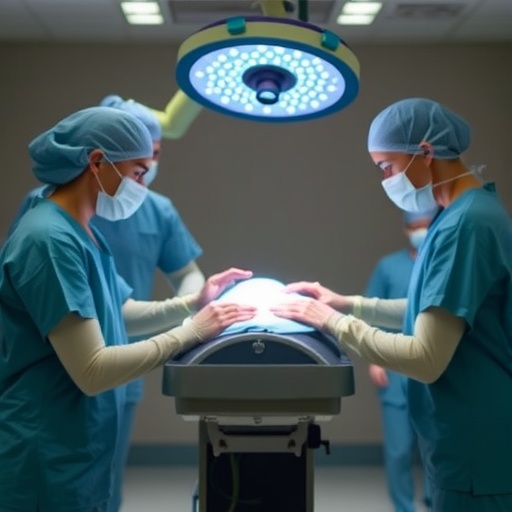New Alzheimer’s research from UVA Health suggests that enhanced light sensitivity may contribute to “sundowning” – the worsening of symptoms late in the day – and spur sleep disruptions thought to contribute to the disease’s progression.

Credit: UVA Health
New Alzheimer’s research from UVA Health suggests that enhanced light sensitivity may contribute to “sundowning” – the worsening of symptoms late in the day – and spur sleep disruptions thought to contribute to the disease’s progression.
The new insights into the disruptions of the biological clock seen in Alzheimer’s could have important potential both for the development of treatments and for symptom management, the researchers say. For example, caregivers often struggle with the erratic sleep patterns caused by Alzheimer’s patients’ altered “circadian rhythms,” as the body’s natural daily cycle is known. Light therapy, the new research suggests, might be an effective tool to help manage that.
Further, better understanding Alzheimer’s effects on the biological clock could have implications for preventing the disease. Poor sleep quality in adulthood is a risk factor for Alzheimer’s, as our brains, at rest, naturally cleanse themselves of amyloid beta proteins that are thought to form harmful tangles in Alzheimer’s.
“Circadian disruptions have been recognized in Alzheimer’s disease for a long time, but we’ve never had a very good understanding of what causes them,” said researcher Thaddeus Weigel, a graduate student working with Heather Ferris, MD, PhD, of the University of Virginia School of Medicine’s Division of Endocrinology and Metabolism. “This research points to changes in light sensitivity as a new, interesting possible explanation for some of those circadian symptoms.”
Alzheimer’s is the most common form of dementia, affecting 50 million people around the world. Its hallmark is progressive memory loss, to the point that patients can forget their own loved ones, but there can be many other symptoms, such as restlessness, aggression, poor judgment and endless searching. These symptoms often worsen in the evening and at night.
Ferris and her collaborators used a mouse model of Alzheimer’s to better understand what happens to the biological clock in Alzheimer’s disease. They essentially gave the mice “jet lag” by altering their exposure to light, then examined how it affected their behavior. The Alzheimer’s mice reacted very differently than did regular mice.
The Alzheimer’s mice, the scientists found, adapted to a six-hour time change significantly more quickly than the control mice. This, the scientists suspect, is the result of a heightened sensitivity to changes in light. While our biological clocks normally take cues from light, this adjustment happens gradually – thus, jet lag when we travel great distances. Our bodies need time to adapt. But for the Alzheimer’s mice, this change happened abnormally fast.
The researchers initially thought this might be because of inflammation in the brain – “neuroinflammation.” So they looked at immune cells called microglia that have become promising targets in our efforts to develop better Alzheimer’s treatments. But the scientists ultimately ruled out this hypothesis, determining that microglia did not make a difference in how quickly mice adapted. (That’s not to say that targeting microglia won’t be beneficial for other reasons.)
Notably, the UVA scientists also ruled out another potential culprit: “mutant tau,” an abnormal protein that forms tangles in the Alzheimer’s brain. The presence of these tangles also did not make a difference in how the mice adapted.
The researchers’ results ultimately suggest there is an important role for the retina in the enhanced light sensitivity in Alzheimer’s, and that gives researchers a promising avenue to pursue as they work to develop new ways to treat, manage and prevent the disease.
“These data suggest that controlling the kind of light and the timing of the light could be key to reducing circadian disruptions in Alzheimer’s disease,” Ferris said. “We hope that this research will help us to develop light therapies that people can use to reduce the progression of Alzheimer’s disease.”
The researchers have published their findings in the scientific journal Frontiers in Aging Neuroscience. The research team consisted of Weigel, Cherry L. Guo, Ali D. Güler and Ferris. The team members have no financial interest in the work.
The research was supported by the National Institutes of Health, grants K08DK097293, T32GM139787 and R35 GM140854; the Owens Family Foundation; and the Commonwealth of Virginia’s Alzheimer’s and Related Diseases Research Fund.
To keep up with the latest medical research news from UVA, subscribe to the Making of Medicine blog.
Journal
Frontiers in Aging Neuroscience
DOI
10.3389/fnagi.2023.1218193




